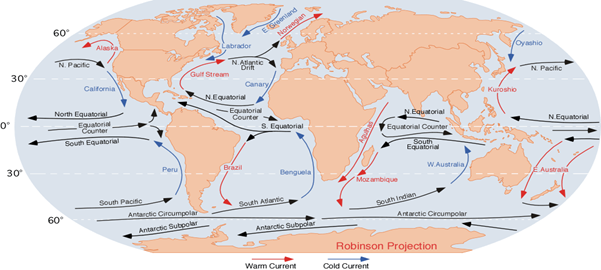Mains Daily Question
Nov. 25, 2020
- What are ocean currents? Discuss the factors that influence the movement of ocean currents. (10 marks)
Approach
- Define ocean currents (may add a line or two about cold and warm currents) - extra points for a rough diagram showing currents (no need to name them all)
- Explain the factors influencing ocean currents like planetary winds, density difference, earth's rotation etc.
- Conclude by briefly noting the impact of ocean currents, like on temperature
Ocean currents are horizontal flow of a mass of waters in a fairly defined direction over great distances. They are like stream of water (like rivers) flowing through the main body of the ocean in a regular pattern. Ocean currents (Avg speed 3.2 km to 10 kmph) with higher speed are called streams and currents with lower speed are called drifts.
Ocean currents are categorized as warm or cold on the basis of relative temperature w.r.t the surrounding water:
- Warm currents generally flow from equatorial regions towards poles. Eg. Kuroshio current, Gulf stream
- Cold currents generally flow from polar regions towards equator. Eg. Oyashio Current, Labrador current.
The circulation of the ocean currents depends on the following factors:
- Planetary Winds: A major role in ocean currents is played by frictional drag of surface water by planetary winds. Most of the currents of the world tends to follow the direction of planetary winds. For example, within the tropics, the trade winds blow from the east and hence, north equatorial and south equatorial currents flow east to west.
- Differences in Density: Differences in water density affect vertical mobility of ocean currents. The less dense water of the equator rises and moves towards the poles (warm current) while the cold and dense waters of the poles sink and move towards the equator (cold current). Similarly, water with lower salinity (lower density) flows on the surface while an undercurrent of high salinity flows towards the less dense water - eg. the current between the Mediterranean Sea with higher salinity and Atlantic Ocean with lower salinity.
- Earth’s Rotation: The earth’s rotation deflects air to its right in the northern hemisphere and to its left in the southern hemisphere. Similarly, ocean water is also affected by Coriolis force and follows the Ferrel’s Law. So, all the ocean currents follow clockwise direction in the northern hemisphere and anticlockwise direction in the southern hemisphere.
- Coastlines and Bottom Reliefs also affect the direction of currents. Eg. The Equatorial current after being obstructed by Brazilian coast bifurcates into two branches.
- Heating by the Sun: Heating by solar energy causes the water to expand. That is why, near the equator the ocean water is higher in level than in the middle latitudes. This causes a very slight gradient and water tends to flow down the slope.
Ocean currents and mixing by winds and waves can transport and redistribute heat to deeper ocean layers. Ocean currents acts to neutralize the temperature difference between different areas in the oceans just like the winds do on land. Currents are also important in marine ecosystems because they redistribute water, heat, nutrients, and oxygen about the ocean.


